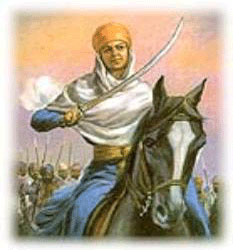Mai Bhago
MAI BHAGO, (Mata Bhag Kaur) the sole survivor of the battle of Khidrana, i.e. Battle of Muktsar (29 December 1705), was a descendant of Pero Shah, the younger brother of Bhai Langah, a Dhillon Jatt who had become a Sikh during the time of Sri Guru Arjan Dev Ji Maharaj. Born at her ancestral village of Jhabal in presentday Amritsar district of the Punjab, she was married to Nidhan Singh Varaich of Patti. A staunch Sikh by birth and upbringing, she was distressed to hear in 1705 that some of the Sikhs of her neighbourhood who had gone to Anandpur to fight for Sri Guru Gobind Singh Ji had deserted him under adverse conditions.
She rallied the deserters persuading them to meet the Guru and apologize to him. She set off along with them and some other Sikhs to seek out the Guru, then travelling across the Malva region. Mat Bhago and the men she was leading stopped near the dhab or pool of Khidrana where an imperial army in pursuit of Sri Guru Gobind Singh Ji had almost overtaken him. The 40 sikhs known as the "Chali Mukte" challenged the Mughal Imperial Army, which entered the battle with 10,000 soldiers, and inflicting such damage onto them, that they had no option but to retreat. Sri Guru Gobind Singh Ji, who had supported them with a shower of arrows from a nearby high ground, found all of the fourty men who had signed a paper dis-avowing him as their Guru, except one, Mahari Singh, had died of their wounds when he visited the battlefield. Mahari Singh, who had been seriously wounded, also died as the Guru took him into his lap.
The Forty Liberated Ones
Sri Guru Gobind Singh Ji blessed those forty dead as the Forty Liberated Ones. He took into his care Mata Bhago who had also suffered injury in the battle. She thereafter stayed on with Sri Guru Gobind Singh Ji as one of his bodyguards, in warrior attire. After the passing of Guru Gobind Singh at Nanded in 1708, she retired further south. She settled down at Jinvara, 11 km from Bidar in Karnataka where, immersed in meditation, she lived to attain a ripe old age.
Her hut in Jinvara has now been converted into Gurudwara Tap Asthan Mai Bhago. At Nanded, too, a hall within the compound of Takht Sachkhand Sri Hazur Sahib marking the site of her residence is known as Bunga Mai Bhago.
References
1. Kuir Singh, Gubilas Patshahl 10. Patiala, 1968
2. Bhai Santokh Singh, Sri Gur Pratap Suraj Granth. Amritsar, 1926-37
3. Piara Singh Padam and Giani Garja Singh, eds., Guru kfari Sakhiari. Patiala, 1986
4. Harbans Singh, Guru Gobind Singh. Chandigarh, 1966

